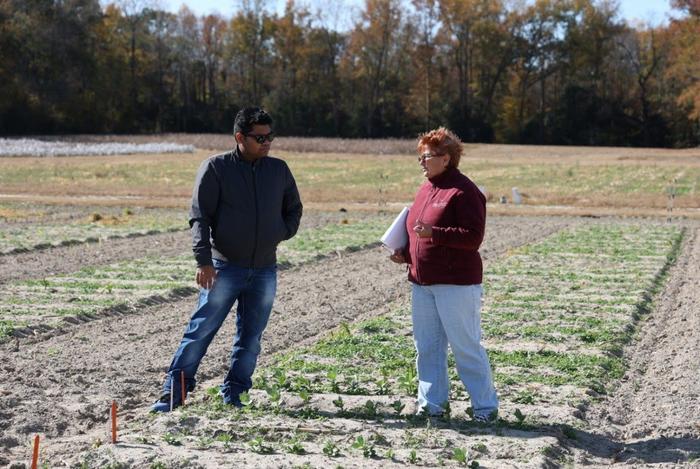Consider the faba bean, also known as the fava bean or broad bean.

Credit: Photo by Suzanne Pruitt for Virginia Tech.
Consider the faba bean, also known as the fava bean or broad bean.
The bright-green legume has been enjoyed as a diet staple for thousands of years in Africa, Asia, and the Mediterranean. Just one cup of faba beans has 13 grams of protein — making it a better protein source than most other legumes — along with plenty of fiber, potassium, and iron. Plus, it’s a good cover crop that helps improve soil health, slow erosion, and control pests, disease, and weeds.
But you don’t often see it in the fields or on the menus in Virginia.
That’s why College of Agriculture and Life Sciences Professor and Virginia Cooperative Extension Specialist Maria Balota is piloting a $2.7 million multistate project funded by the U.S. Department of Agriculture’s National Institute of Food and Agriculture Specialty Crops Research Initiative to introduce the faba bean as a sustainable fall and winter crop in the mid-Atlantic region.
“Growing resilient crops to climate change is one way to achieve agricultural sustainability in an evolving environment,” Balota said. “We can improve traditional plant varieties’ tolerance of more extreme temperatures and rainfall through breeding. But in addition to this strategy, we can scavenge for crops that fit this new environment naturally. Faba beans are a cool-season legume that fit well into the winter production systems of the mid-Atlantic.”
Balota is teaming up with School of Plant and Environmental Sciences Associate Professor David Haak, food science and technology Professor Sean O’Keefe, and other researchers from Virginia Tech, Virginia State University, University of Maryland, North Carolina State University, and the University of Delaware to conduct on-farm field studies of the faba bean in each state.
In addition to cultivating hardy faba beans that can thrive in the mid-Atlantic’s fall and winter climate, researchers plan to develop the most nutritious and flavorful beans to appeal to consumers.
They will also create Extension programs for farmers and industry partners and convene a Faba Bean Advisory Committee. The committee, composed of researchers, growers, processors, seed producers, Extension agents, and farmers market representatives, will meet annually to evaluate the program and the faba bean’s potential for broader production.
“The faba is gaining popularity in Europe and United States because of an increased trend in veganism,” said Balota, who is based at the Tidewater Agricultural Research and Extension Center. “Among the pulses, the faba bean has the highest protein content – 50 percent over that of lima beans based on our preliminary data – which makes it a fabulous choice for plant-derived protein products for vegan diets. Of course, fresh and dry faba seed consumption is perfectly reasonable in hummus, soups, and sautéed and puréed dishes. Or, if you like, in salads along with young, fresh leaves. Stems and old leaves can go into the ground to improve the soil. Everything is useable from it.”
Federal and state incentive programs reward the planting of cover crops as a climate-smart practice that reduces erosion and runoff, improves soil health, and supports bees and other pollinators. Virginia farmers grow over 430,000 acres of cover crops, predominantly as a means of enhancing soil nutrients before planting cash crops in the spring.
The researchers hope that the faba bean will prove to be a sustainable cover crop and cash crop that brings nutritional, environmental, and economic benefits to the region.
“Why not attempt to grow a legume – either as a green faba bean or dry fava seed – as a major crop that can bring farmers soil benefits along with some cash?” Balota said. “It’s a win for Virginia’s farmers, the state’s economy, and the climate.”
Other Virginia Tech researchers on this project include
- Abhilash Chandel, assistant professor of precision agriculture technologies and data management at the Tidewater Agricultural and Research Extension Center
- Joseph Oakes, superintendent of the Eastern Virginia Agricultural and Research Extension Center
- Renata Carneiro, research assistant professor in the Department of Food Science and Technology
- Alejandro Del-Pozo, assistant professor of entomology at the Hampton Roads Agricultural and Research Extension Center
- Douglas Higgins, assistant professor of plant pathology and Extension specialist at the Eastern Shore Agriculture Research and Extension Center




